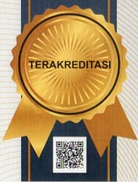Prediksi Laju Infiltrasi Metode Flooding Ditinjau Dari Karakteristi Tanah pada Kawasan Banjir di Kota Balikpapan Tengah
Abstract
Floods are the thiird highest natural disaster occurrence in Balikpapan City after landslides (38.36%) and fallen trees (35.85%). Flood locations experienced an increase in incidence, one of which was in Sumber Rejo Village, Central Balikpapan, Balikpapan City. In 2020 increased to 7 events (an increase of 25.71%). Central Balikpapan District is a flooded area that has a lot of land covered with morphological conditions located on a steep slope, having an area of 2,205 Km2. The high intensity of rainfall has caused some parts of this area to be affected by floods it can disrupt the activities of local residents. This study was conducted in a high-flood area, namely in the sub-district of Central Balikpapan, using the Horton, Holtan and Philip Method of analyse and the flooding method. Based on the result of the analysis and testing on the studies that have been carried out, the land cover for the measurement location of Land (TK), Angsana Tree (PA), Shurbs (SN), Jackfruit Tree (PN). Soil classification is sandy loam and clayey sand, and porosity category are low and medium. Analysis of the actual infiltration rate for location PN 8.52% cm/hour (slightly fast), SB 4.32 cm/hour and PA 2.55cm/hour (moderate) and TK 1.98 cm/hour (slightly slow). Horton’s model is suitable for use in this location because it can be applied to variants in land cover. The results of the analysis of the method starting at the 10th minute to the 180th minute still occurred inundation even though the inundation condition decreased. This shows that the four-measurement location in the flood of Balikpapan City have very small infiltration rates.
Full Text:
PDF (Bahasa Indonesia)References
BPS kota Balikpapan, “Badan Pusat Statidtik Kota Balikpapan 2021,” 2021.
P. K. Balikpapan, “Rencana Pembangunan Jangka Menengah Kota Balikpapan,” 2016.
M. S. A. Hapsary, S. Subiyanto, and H. S. Firdaus, “Analisis Prediksi Perubahan Penggunaan Lahan Dengan Pendekatan Artificial Neural Network Dan Regresi Logistik Di Kota Balikpapan,” J. Geod. UNDIP, vol. 10, no. 2, pp. 88–97, 2021, [Online]. Available: https://ejournal3.undip.ac.id/index.php/geodesi/article/view/30637.
K. Tv, “Banjir Kota Balikpapan,” 2022.
M. Kiptiah, A. A. Soeparla, R. B. Giarto, and P. N. Balikpapan, “P-34 Analisis Laju Inflitrasi pada Variasi Penggunaan Lahan Analysis Of Infiltration Rate Use Variation In,” pp. 233–241, 2021.
M. Kiptiah, E. Asmanajaya, and R. B. Giarto, “Analisis,” J. Sipilsains, vol. 10 2, no. September, pp. 151–156, 2020, [Online]. Available: http://ithh.journal.ipb.ac.id/index.php/p2wd/article/view/22930.
L. D. Susanawati, B. Rahadi, and Y. Tauhid, “Penentuan Laju Infiltrasi Menggunakan Pengukuran Double Ring Infiltrometer dan Perhitungan Model Horton pada Kebun Jeruk Keprok 55 (Citrus Reticulata) Di Desa Selorejo, Kabupaten Malang,” J. Sumberd. Alam dan Lingkung., vol. 5, no. 2, pp. 28–34, 2018, doi: 10.21776/ub.jsal.2018.005.02.4.
Q. M. Bagaskoro, S. Wahyuni, and U. Andawayanti, “Analisis Laju Infiltrasi Dengan Metode Penggenangan (Fooding) dan Karakteristik Tanah di Kabupaten Sampang, Madura,” J. Teknol. dan Rekayasa Sumber Daya Air, vol. 1, no. 2, pp. 477–488, 2021, doi: 10.21776/ub.jtresda.2021.001.02.12.
Badan Standar nasional, “Cara Uji Analisis Tanah,” 2012.
F. Todisco, L. Vergni, A. Vinci, and D. Torri, “Infiltration and bulk density dynamics with simulated rainfall sequences,” Catena, vol. 218, no. August, p. 106542, 2022, doi: 10.1016/j.catena.2022.106542.
W. Arianto, E. Suryadi, and S. D. N. Perwitasari, “Analisis Laju Infiltrasi dengan Metode Horton Pada Sub DAS Cikeruh,” J. Keteknikan Pertan. Trop. dan Biosist., vol. 9, no. 1, pp. 8–19, 2021, doi: 10.21776/ub.jkptb.2021.009.01.02.
M. Zhao et al., “Soil matrix infiltration characteristics in differently aged eucalyptus plantations in a southern subtropical area in China,” Catena, vol. 217, no. December 2021, p. 106490, 2022, doi: 10.1016/j.catena.2022.106490.
R. Ruggenthaler, G. Meißl, C. Geitner, G. Leitinger, N. Endstrasser, and F. Schöberl, “Investigating the impact of initial soil moisture conditions on total infiltration by using an adapted double-ring infiltrometer,” Hydrol. Sci. J., vol. 61, no. 7, pp. 1263–1279, 2016, doi: 10.1080/02626667.2015.1031758.
E. R. Turner, “Comparison of Infiltration Equations and T heir Field Validation With Rainfall Simulation,” p. 202, 2006.
S. Ritawati, M. Mawardi, and S. Goenadi, “Kesesuaian model infiltrasi philips untuk prediksi limpasan permukaan menggunakan metode bilangan kurva,” Agritech, vol. 32, no. 3, pp. 331–339, 2012.
N. L. Sy, “Modelling the infiltration process with a multi-layer perceptron artificial neural network,” Hydrological Sciences Journal, vol. 51, no. 1. pp. 3–20, 2006, doi: 10.1623/hysj.51.1.3.
I. W. Setiawan, D. Harisuseno, and S. Wahyuni, “Studi Laju Infiltrasi Dengan Menggunakan Model Horton dan Model Kostiakov Pada Beberapa Tata Guna Lahan,” J. Teknol. dan Rekayasa Sumber Daya Air, vol. 2, no. 1, pp. 91–104, 2022.
DOI: https://doi.org/10.32487/jst.v8i2.1630
Refbacks
- There are currently no refbacks.
Copyright (c) 2023 JST (Jurnal Sains Terapan)
View My Stats


